
Why and how to crate train your dog

Philippa Short
4 May 2023 | 12 minutes read
Crate training is an important skill to teach any dog, young or old. Expert dog behaviourist Philippa Short shares her top tips for making the experience successful and enjoyable for both you and your pooch.
- What is crate training?
> What size crate do I need for my dog? - Why should you crate train a puppy?
> Should I follow a crate training schedule? - How to set up your dog’s crate
- How to crate train a puppy
> Teaching your puppy to enjoy time alone in the crate
> Teaching your puppy to go to their crate on cue - How to crate train an older dog
- Crate training safety tips
- When should you stop crate training?
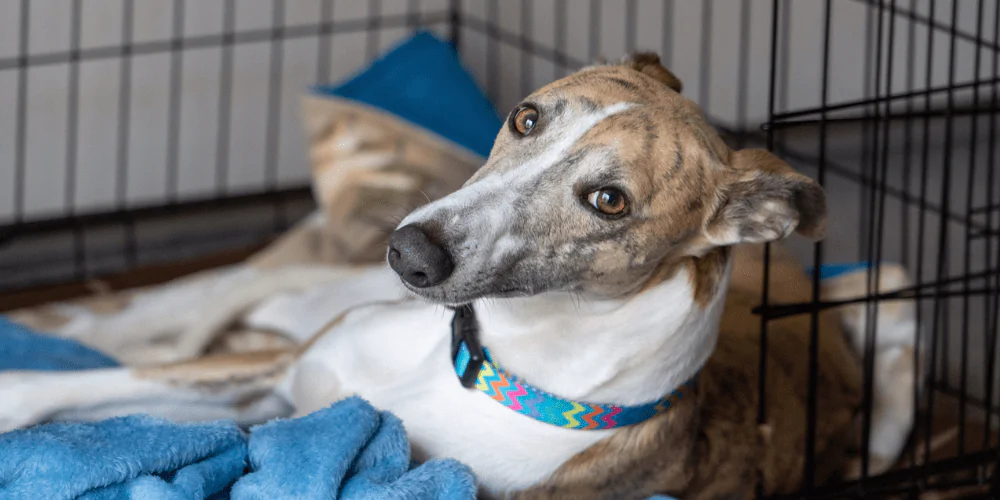
What is crate training?
Crate training is teaching your dog to be comfortable staying in a safe, contained area – it’s why I prefer to call it ‘containment training’.
There’s lot of options for containment areas, such as:
- Fabric crates
- Wire crates
- Furniture with built-in crates (like side tables)
- Puppy/baby pens
- Child room dividers
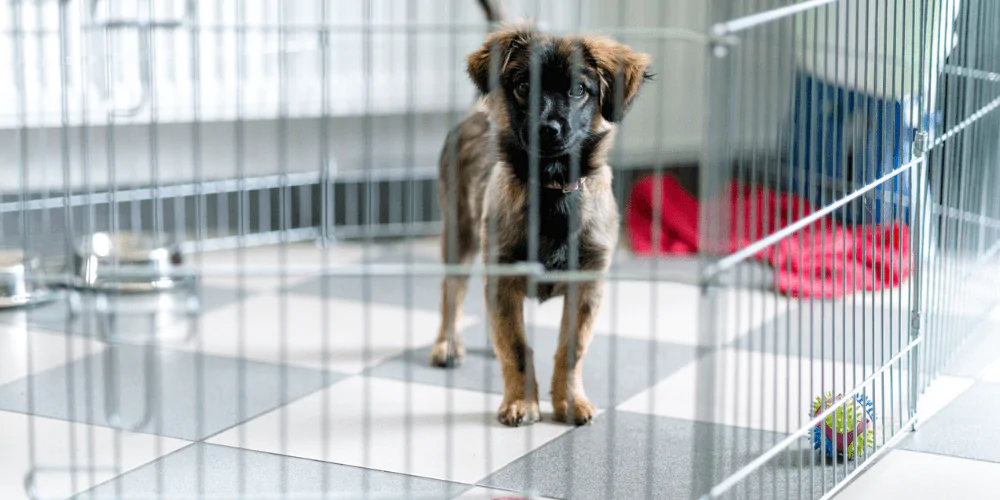
> What size crate do I need for my dog?
There’s many debates about what crate size to choose for your dog.
The old-fashioned approach is to pick a crate that’s just big enough for your dog to comfortably:
- Stand up in their normal position
- Lie down in a sphynx or flat-out position
The idea behind giving your puppy a smaller space is to try and stop them from going to the toilet where they sleep. Too big of a crate means they’ll sleep on one side and go to the toilet on the other.
I personally choose to start off with a crate that’s at least twice the size of what the puppy needs it to be. I’ll then attach a puppy pen around the crate and place puppy pads in the pen.
Having this set up:
- Creates a safe, comforting, and warm area
- Helps your puppy not feel cramped
- Gives them somewhere to go if they need an emergency toilet break
Everything is new to your puppy in those first few weeks of being home with you. You don’t want them to get stressed out when they have accidents, so it’s better to give them a place to go.
But remember, the pads are a temporary solution while you teach your puppy toilet training. You still need to help them understand that they go to the toilet outside and teach them how to hold their bladder.
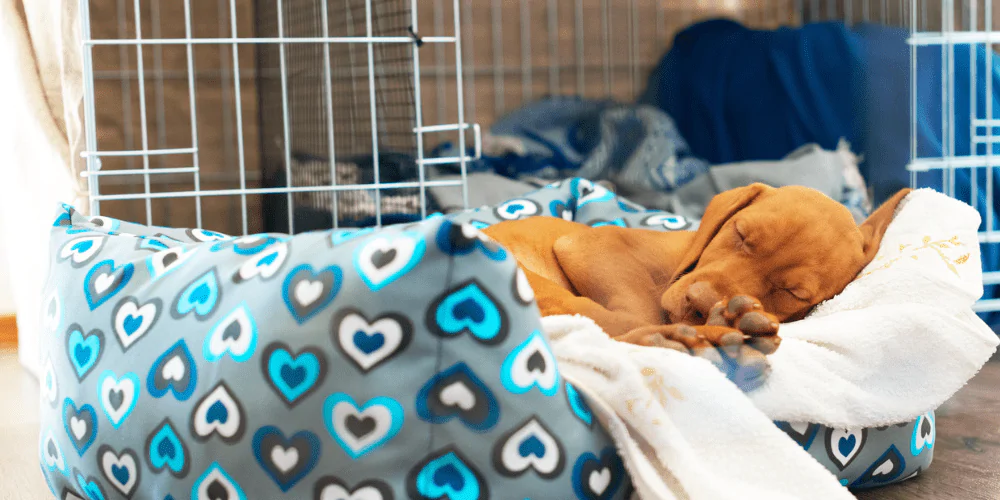
Why should you crate train a puppy?
Humans can see crates (and other contained areas) as a place that restricts the freedom and movement of dogs. True, this can happen if you’ve introduced it or used it incorrectly.
But your dog won’t feel this way if you take the right approach and make it a welcoming, warm, safe, and fun place for them.
I see containment training as an important skill your dog will need at some point in their life. There are times when they’ll need to be contained, such as:
- Having to stay at the vets
- Resting after surgery or an injury
- Being around workmen in the house
- Getting some peaceful nap time
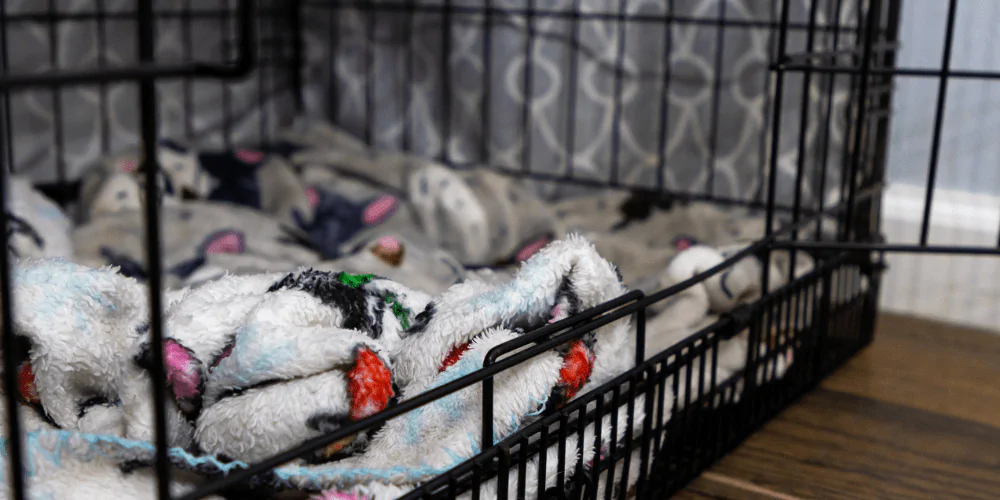
> Should I follow a crate training schedule?
Although I think patterns and schedules are important, I don’t think they hold much value when they’re super regimented.
I use schedules for dogs with behavioural issues (such as extreme anxiety) as they need predictability.
But I wouldn’t generally follow a strict training schedule with a healthy dog as it can make their day too structured. Breaking this structure (for example, you can’t get out for a walk one day) can then cause them a lot of distress and anxiety.
I’d give your dog an ‘ish’ pattern, meaning they do and get things between certain periods rather than at exact times of the day. So they know breakfast is given between 7am and 9am, instead of exactly 8am each time.
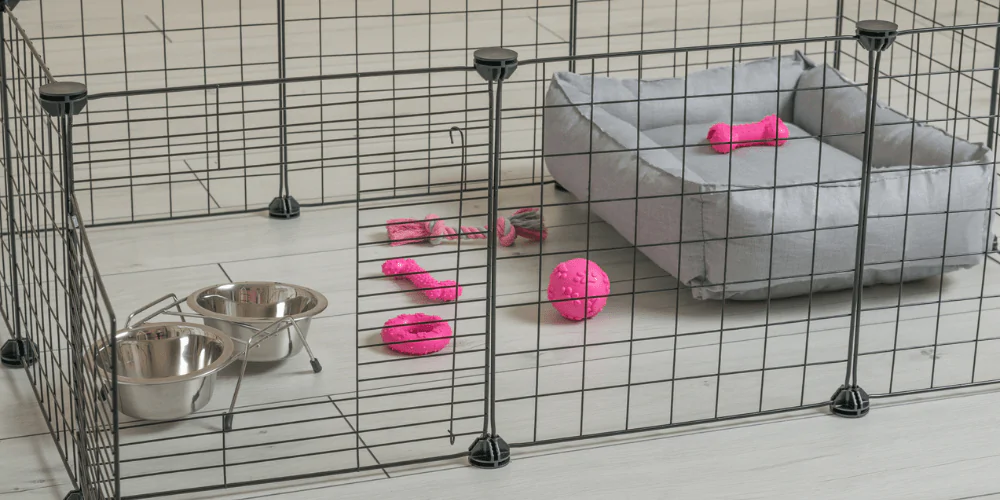
How to set up your dog’s crate
Before we get into the hows of crate training, let’s get everything set up for your puppy.
- Choose the type of crate you want to use – As we mentioned earlier, this could also be another type of containment area, like a pen or gated-off room.
- Decide how many crates you need – For example, you might have one in the bedroom for when they’ve just come home with you (and so feeling more anxious). You could also have one in the living room (that they’ll move over to as they settle in).
- Pick where to put the crate – Think carefully about where in the house is comfortable for your pup:
> Temperature – is it drafty or under a big window that gets too hot in the summer?
> Noise – it is in the middle of a busy thoroughfare, or somewhere that’s too quiet with absolutely no interaction?
> Access to outside – are they too far away from the back door and will struggle to hold their bladder before getting out for the toilet? - Put in your puppy’s bedding – The time of year will decide what bedding to use.
> You want to make sure they’re not too hot or cold. A bigger crate allows you to set up a warmer bedding side and a cooler side to give your pup more choices.
> Crate bumpers can help your puppy comfortably cuddle up in corners.
> An absorbent vet bed is a great bottom layer for the crate. It gives a basic layer of comfort and wicks away any accidents.
> Whatever you layer on top of the crate will depend on your dog. Get some really tough crate liners if your puppy likes to chew. - Add on eating and drinking accessories – All dogs should have 24 hour access to fresh water, unless a vet has said otherwise. You can get clip or screw-on bowls to suit your crate set-up. Be wary of freestanding bowls as your puppy will sit, dig, and play in them!
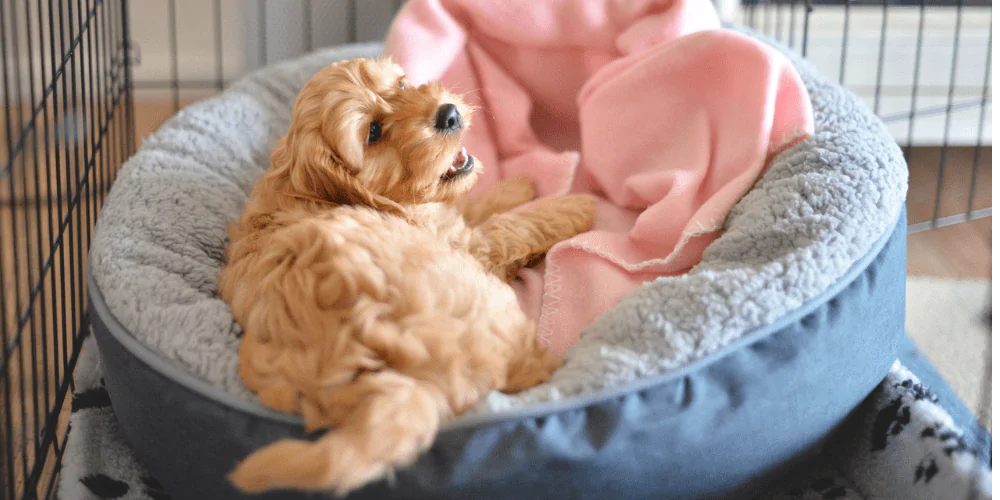
How to crate train a puppy
Some good breeders (especially those who use puppy culture) will have already introduced their puppies to crates.
Many puppies will have been raised in a puppy pen and so understand the idea of being contained. But it’s likely that the first time they see a crate is when they come home to you.
The crate/containment area should be a positive place that your puppy wants to be in. It’s where they’ll eat all of their meals, are given treats, and play with new toys (under supervision, and nothing that can be destroyed).
There’s two sides to crate training puppies:
- Teaching your puppy that they want to go in, explore, and hang out there without you
- Teaching your puppy to go in when asked
The following steps are for single-dog households, as there’s a risk of creating guarding issues in multi-dog households. If you have more than one dog, speak to a qualified behaviourist for support with crate training your puppy.
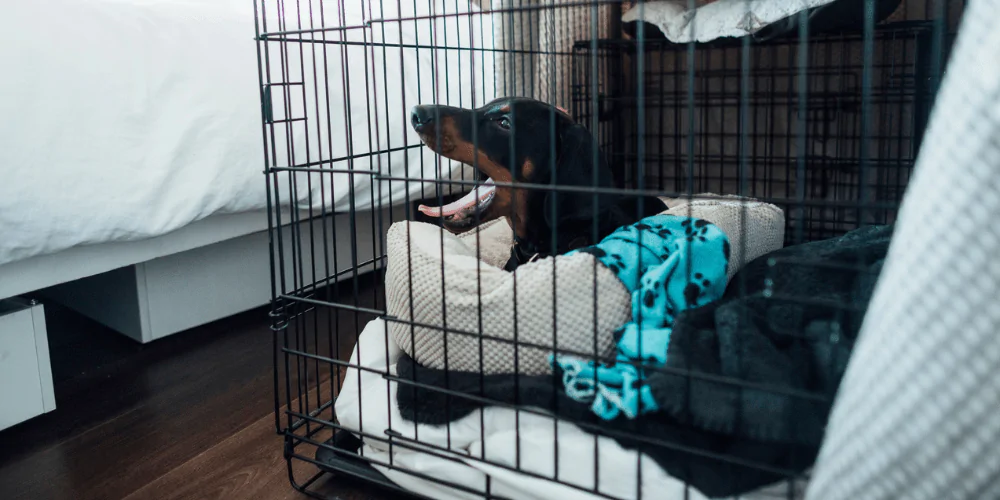
> Teaching your puppy to enjoy time alone in the crate
To teach your puppy to spend time in their crate/area independently:
- Put their food bowl in the crate and leave the door open. Let them wander in, eat, and wander out. Any new toys will also be put in here.
- Get your puppy regularly going in and out of the crate/area to eat meals. At this point, you can scatter in a few treats each time you take their empty bowl away. Do this for three to four days. Your puppy catches the scent, wanders back in, and finds their tasty treasure. They’re starting to see the crate as a giver of good things.
- At day four or five, safely tie a Kong, food toy, or their favourite chew to the back of the crate. Doing this means your puppy has to go in and hang out in the crate longer to enjoy their treasure. You don’t want your puppy going in just to please you – you’re teaching them to want to go in there for themselves.
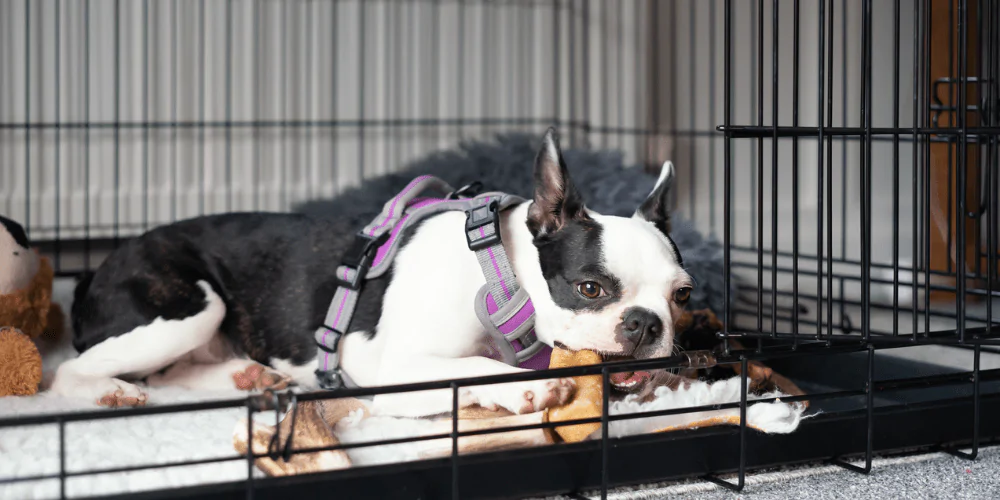
> Teaching your puppy to go to their crate on cue
To teach your puppy to go to their crate/area when asked, we’re going to play a game:
- Choose your cue, which could be ‘in your crate/spot/place’. Take a treat, say your cue, and throw the treat in the crate. Praise them when they go in and eat the treat. Throw a treat when they come back out of the crate, then throw another one when they go back in.
- Start throwing treats in through the top of the crate or bars. Keep the door open so your puppy can leave anytime. But they should choose to stay there as treats are being dropped in for them.
- Instead of luring your puppy in with treats, walk towards the crate and say your cue. Let your puppy think about it and choose to go in without being lured. As soon as they go in, give them lots of praise and several treats. Now you’ve gone from food luring to food rewarding.
- When your puppy is regularly going in the crate, give them a treat and close the door behind them. Keep praising them, adding in a treat every second for a couple of seconds. Then open the door, say OK, and let your puppy come out. The rewards are now only given if the door is closed behind them.
- See if you can stand at all angles around the crate and your puppy still happily goes in. You also want them to be able to go further away from you to get into the crate.
- Slowly build up the length of time you keep the crate door closed. Start giving them their food with the door closed, making sure to stay close by. Going slowly and watching carefully helps you pre-empt when they want to come out. You can then open the door before they become distressed.
Key things to note:
- You need plenty of rewards when trying to teach your dog to spend more time in their crate. It can be a treat, Kong, or chew toy, just make sure your puppy always gets something when they’re asked to go in.
- Building up the amount of time they spend in the crate is often easier at night as it’s dark and quiet.
- Don’t open the door if your puppy has barked or is bashing it with their paw. This is teaching your dog to bark for your attention, so it’s important to be proactive and let them out before they show this behaviour.
- You’re teaching your puppy that they can’t just run around the house and get over-excited. They start to relax more and enjoy the peace that a contained area gives them.
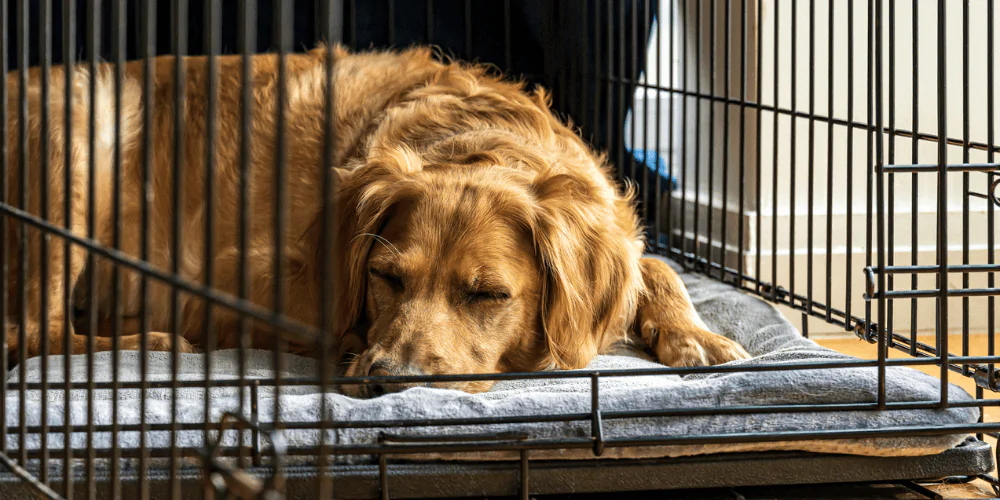
How to crate train an older dog
An older dog who’s new to being contained or had positive experiences can follow the same training steps as a puppy.
But things can be trickier if your senior pup has had a negative crate experience in the past. For example, if they were rescued from spending their life shut in a shed.
So you’ll need to spend more time doing crate games and leaving the door open if they’re afraid of being confined. You’re teaching them that they have choice and helping to rebuild a good emotional response to being in a confined area.
Speak to a behaviourist if you’re still really struggling to crate train an anxious older dog.
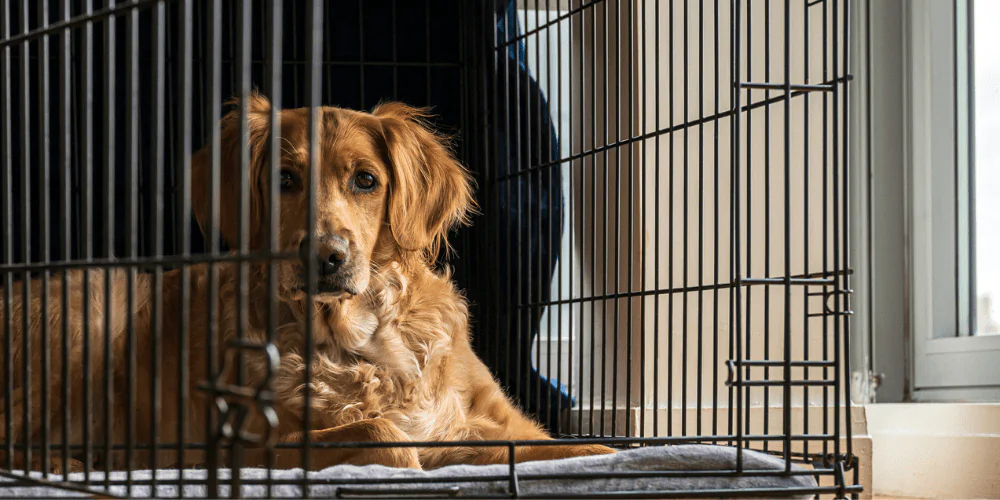
Crate training safety tips
Your dog’s safety is absolutely essential, so it’s important to be aware of the potential risks and dangers of using a crate:
- Never put your dog in a crate while they have a collar on. Your dog could push their nose through and catch their collar.
- Always check a crate carefully when buying one second-hand. Make sure all the bars are safe, there’s no rust, and it’s only been used inside.
- Be wary of using blankets or sheets over the crate if you have an inquisitive puppy. They can pull them down to chew and swallow bits of the fabric. There’s also been the rare time where they create a loop and get tied up. Bespoke-made crate covers are available but can be more expensive.
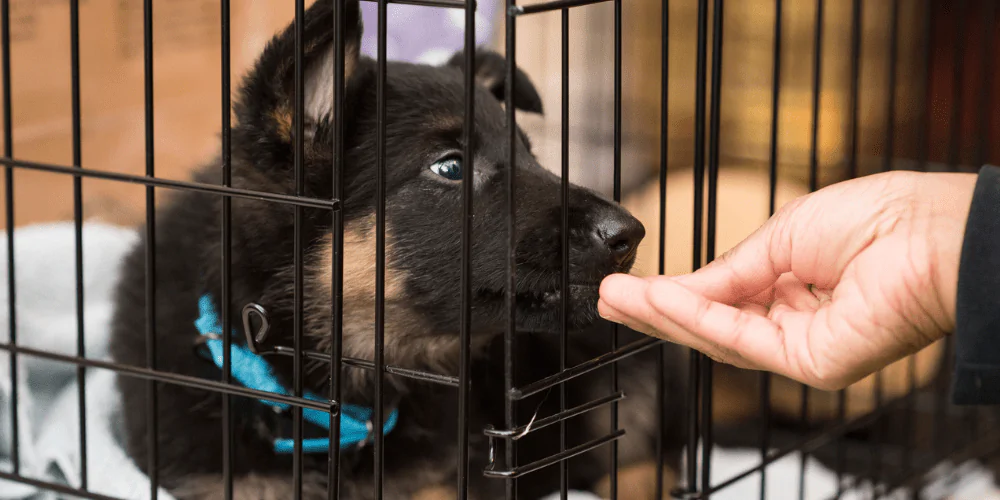
When should you stop crate training?
No dog or puppy (unless under crate rest from the vet) should spend more than fours hours in a crate during the day. You’ll need to regularly check on them and give them cuddles.
Overnight is slightly different – it’s fine for your pup to spend seven to eight hours in their crate as they’re mainly sleeping. This is where having a bigger crate with more space helps.
Teaching your dog to go into their crate on cue should come quite quickly if you’re being consistent with your training. It’s all about what you put in (and not making the experience negative for your pup).
Helping your dog build good emotional feelings about a contained area depends on:
- Pacing things correctly
- Making sure they’re comfortable (the area isn’t too small)
- Leaving lots of treasure for them to find without you there
You can also use calming sprays and scents to encourage relaxation and sleep in the crate.
Remember:
- Don’t rush any of the training steps as your dog will feel abandoned in the crate with no choice to leave.
- Ignore attention barking (which is different to anxious barking) – attention barking happens if you’ve not worked on each step enough.
- You’ll create a negative experience if your puppy is only contained when you’re going out. Spend lots of time next to the crate/area while your puppy is in there. For example, put them down for a nap or when you need to clean the house. This tells your pup that you’re still around so they can feel secure in their contained area.
With Petsure dog insurance, you can claim for behavioural sessions with a qualified animal behaviourist.


